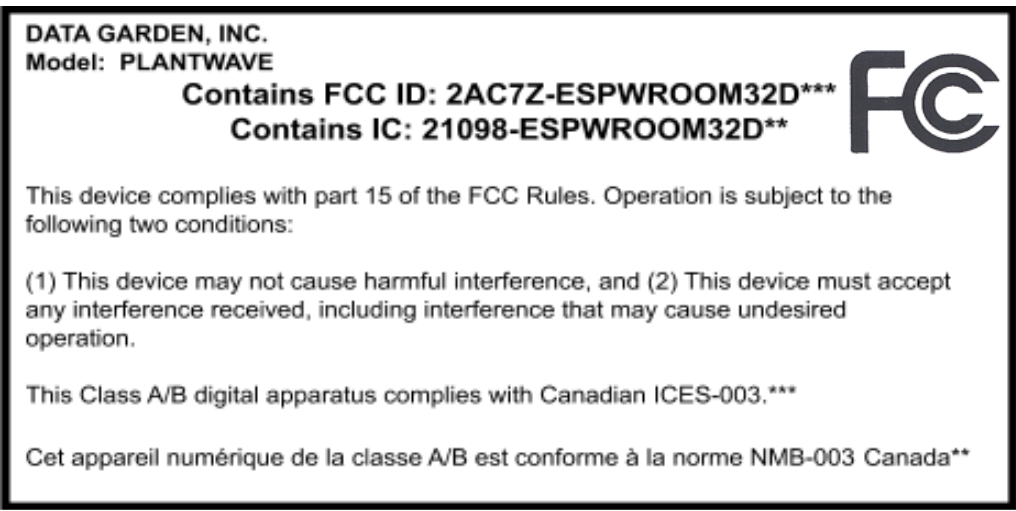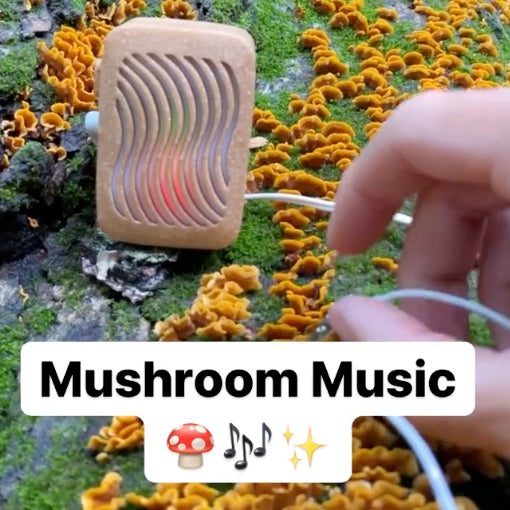Manual
Welcome!
Thank you for being a part of this new form of interspecies collaboration we are calling PlantWave. It is our belief that, by creating harmony with nature rather than trying to control it, we humans can have a more enjoyable and sustainable time here on Earth. By tuning into plants through PlantWave, we hope to facilitate space for humans to acknowledge our interconnection with all beings, allowing us to be more gentle with our partners on this journey as well as ourselves. With that, we hope you will take a moment to read through the “Before You Start” section as well as the one on removing electrodes. Let's be gentle with our little green collaborators.
Please visit our Help Center if you need additional assistance.
Happy listening!
What's Included

Figure 1
A) PlantWave
B) Electrode Pads
C) Electrode Leads
D) USB-C to USB 3.0
E) Mushroom Clips (for use on mushrooms only, will not work on most plants)
F) Electrode Clips (for smaller plants / short term use)
Your PlantWave

Figure 2
A) Lightshow
B) Power On/Off
C) Status Indicator Light
D) Mode / Pairing button
E) Electrode Input
F) USB C Port (for power, charging, MIDI and data transfer)
G) 3.5mm MIDI Out - Type A WARNING: This is not a headphone / audio jack.
(For advanced use / connecting to synthesizers)
H) Charging Indicator Light
Before You Start
Charge the Battery
PlantWave ships with the battery charged around 20% but sometimes can arrive fully depleted. It is recommended that, upon receiving PlantWave, the device is charged 2-4 hours before first use.
Charging the Battery
-
Connect the provided USB 3.0 to USB-C cable from a power source to your PlantWave's USB-C port.
-
Note, it is not recommended plug an Apple laptop charger into PlantWave. This could cause delays in charging.
-
-
When charging, the battery indicator lights will appear red and green..
-
When charging is complete, the battery indicator lights will appear green.
Battery Life
PlantWave has a battery life of 22-24 hours by default. Longer life can be achieved by turning off the LED light show and other options available in the Settings section of the PlantWave app.
Electrode Pads vs. Clips vs. Mushroom Clips
The electrode pads (those sticky oval things) that come with your PlantWave are reusable and, in most cases, are safe to leave on your plant for months or years at a time. The pads connect to leads, which are the white wires that snap onto the pads.
The electrode clips are not intended for long-term use on plants. These are best used on plants that have leaves too small or delicate for pads. They also come in handy when using PlantWave in situations where you want to switch from one plant to another quickly and easily.
The white mushroom clips are a more delicate sensor specifically designed for use with fungi. It is not recommended for use with plants as it will not consistently pick up a signal. For the best results with plants, please use the included electrode pads or metal clips.
Before Selecting a Plant or Leaf
-
Is the leaf you want to connect to larger than the electrode pad or clip? It's best to be working with a larger leaf as this will provide more variation in conductivity and it will also be easier to remove your electrodes when you're done listening.
-
Is the leaf / plant strong enough to hold the electrode/clip or will it put stress on the plant and weigh it down? Using PlantWave with a plant is a way of engaging in a conversation or partnership with your plant. Don't stress it out. If it's too small to handle the weight of the electrodes, let it be.
Preparing Your Plants
-
Prepare two leaves on your plant by gently cleaning them with soapy water. (most plants purchased from nurseries and department stores are covered by fungicidal gel that can interfere with connection to the PlantWave)
-
Gently dry your plant leaves.
Connecting to Your Plant
-
Place your PlantWave near your plant
-
Connect Pads+Leads or Clips to the plant
-
If using Pads + Leads:
-
Remove a pair of electrode pads from their bag, keeping the plastic protectors on the pads.
-
Connect the snaps from the leads onto the back of the electrode pads. (It is best to connect the snaps to the pads before placing them on your plant to avoid applying excess pressure on the leaf during the snap-on process)
-
Remove the plastic protectors on the electrode pads and affix the pads to the leaves. Place the plastic protectors back in the bags to save for later use.
-
-
If using Clips:
-
Attach the clips to two leaves on your plant
-
-
Connect the electrode lead or clip cable to the Electrode Input on your device and continue following the set up instructions.
A Note on Removing Electrode Pads from Plants
-
Always remove the electrode pad by peeling it off of the leaf from the stem or branch towards the end of the leaf. This method works best with the structure of a leaf to ensure that it isn't torn.
-
Always support the leaf near the stem by holding it with one hand while peeling with the other. This ensures you don't pull the leaf from its plant
-
Be patient and take your time. It may sometimes take up to a minute to remove an electrode pad in a way that ensures you do no damage. Take this as an opportunity to thank your plants for singing to you. They will surely be happy you've taken this extra time.
Using the PlantWave App
iOS Instructions
-
Open the app
-
Power on your PlantWave by moving the power switch away from the Mode button.
(The status indicator light near the power switch will start flashing) -
In the top of the PlantWave app, Tap on “Connect”
-
Under “My Devices”, tap “Connect PlantWave”
-
Press the Mode / Pairing button on your device. The app will recognize your PlantWave and it will now appear under “My Devices”
-
Select your device and return to the home screen.
-
Now your plant is playing music with your PlantWave!
Android Instructions
-
Open the app
-
Power on your PlantWave by moving the power switch away from the Mode button.
(The status indicator light near the power switch will start flashing) -
In the top of the PlantWave app, Tap on “Connect”
-
Tap on your PlantWave device when it appears on the screen
-
Tap “Pair & Connect” from the dialogue that appears at the top of your screen
-
Tap “Pair” on the confirmation dialogue that appears in the middle of your screen
-
Press the “X” in the upper right corner to return to the home screen.
-
Now your plant is playing music with your PlantWave!
Advanced Uses
Enable MIDI Mode for 3.5mm and USB ports
PlantWave has a 3.5mm Type A MIDI jack, which can be connected to other Type-A MIDI devices via a 3.5mm stereo aux cable or to 5-pin MIDI synths via a Type-A MIDI Adapter.
PlantWave can also send MIDI via USB.
PlantWave cannot be directly connected to a Type-B MIDI synth without special configuration. For more info on Type-A vs Type-B MIDI, visit minimidi.world
Factory settings of PlantWave's firmware have MIDI turned off. MIDI can easily be turned on via our app or a web browser.
Edit MIDI Settings on your device via iOS App
-
Turn on your PlantWave
-
Open the PlantWave iOS app
-
Pair your App with your PlantWave in the Connect section
-
Go to “Settings” in the top left corner
-
Tap on “Devices”
-
Tap on your device
-
Tap on Advanced MIDI Settings
-
Edit your settings
-
Click Done
-
The settings are now active on your device
Edit MIDI Settings on your device via Android App
-
Turn on your PlantWave
-
Open the PlantWave Android app
-
Pair your App with your PlantWave in the Connect section
-
Tap the Gear icon next to your device in the Connect section
-
Tap on the Arrow next to MIDI Settings
-
Edit your settings
-
Click the “<” icon or back button to return to the previous screen
-
The settings are now active on your device
Edit MIDI Settings on your device via Web Browser
PlantWave can be connected to WiFi via a 2.4GHz network and be accessed by a web browser. Most wireless routers include a 2.4GHz and a 5GHz network. When setting up your PlantWave, you'll need to connect it to your 2.4 network. Once it's connected, you should be able to access it via both your 2.4 and 5GHz networks on your wireless router.
-
Turn on PlantWave
-
Find the PlantWave WiFI
-
Connect to it (you will lose your Internet connection)
-
Navigate to 192.168.4.1 via a web browser
-
Enter WiFi credentials for the 2.4GHz channel on your WiFi network
-
Your PlantWave will now restart and the PlantWave signified by the lightshow on your device. The PlantWave WiFi network will also become inactive and disappear from your WiFi networks
-
Connect your computer to your WiFi network
-
Navigate to http://plantwave.local/ in a web browser
-
If you have changed your device name, replace plantwave.local with <device-name.local> (for instance, http://snakeplant.local)
-
-
Change your MIDI settings and click “Save”
Use PlantWave with a Digital Audio Workstation (DAW)
Connect to DAW via WiFi for the first time (Mac)
PlantWave can be connected to WiFi via a 2.4GHz network. Most wireless routers include a 2.4GHz and a 5GHz network. When setting up your PlantWave, you'll need to connect it to your 2.4 network. Once it's connected, you should be able to access it via both your 2.4 and 5GHz networks on your wireless router.
Note that holding the mode button for six seconds while your PlantWave is powered on will toggle on/off your device's WiFi
-
Turn on PlantWave
-
Find the PlantWave WiFI on your Mac
-
Connect to it (you will lose your Internet connection)
-
Navigate to 192.168.4.1 via a web browser
-
Enter WiFi credentials for the 2.4GHz channel on your WiFi network
-
Your PlantWave will now restart, signified by the lightshow on your device. The PlantWave WiFi network will also become inactive and disappear from your WiFi networks
-
Connect your computer to your WiFi network
-
Navigate to http://plantwave.local/ in a web browser
-
You will now see you are connected to the PlantWave through your WiFi network
-
Open Audio MIDI Setup on your Mac and navigate to MIDI Studio
-
Click on MIDI Network Setup (it looks like a connected globe)
-
Click the Plus (+) under "My Sessions"
-
Name your Session and enable it by clicking the checkbox
-
Find your PlantWave in the Directory
-
Highlight your PlantWave in your Directory and then click "Connect"
-
You will now see your PlantWave as a participant
-
Go to your digital audio workstation, and you will see your PlantWave listed as an input.
-
Make sure Track and Remote are both selected. This will send MIDI note and MIDI CC messages from your PlantWave
-
Now you can set your PlantWave as an input on any of your MIDI channels, just like you would a MIDI controller.
-
Add some MIDI Scalers and Arpeggiators and watch the magic happen.
Connect to DAW via USB (Mac)
To use this feature, you must have your device in MIDI mode. See the section, “Enable MIDI Mode for 3.5mm and USB ports” and then continue on with the below instructions.
-
Make sure your PlantWave is ON before plugging it into USB (otherwise, it could go into USB serial mode)
-
Plug your PlantWave into a USB cable and connect it to your computer
-
Your PlantWave will appear in the MIDI settings of your DAW
-
If you do not see your PlantWave listed, try disconnecting and reconnecting your USB cable. Note that restarting your device will not have an effect.
Connect to DAW via ⅛” (3.5mm) MIDI
To use this feature, you must have your device in MIDI mode. See the section, “Enable MIDI Mode for 3.5mm and USB ports” and then continue on with the below instructions.
-
Follow the instructions for “Connect to a MIDI Synth” and connect PlantWave to your MIDI interface on your computer.
Use with a MIDI Synthesizer
To use this feature, you must have your device in MIDI mode. See the section, “Enable MIDI Mode for 3.5mm and USB ports” and then continue on with the below instructions.
Connect to a MIDI Synthesizer
PlantWave features a ⅛” (3.5mm) Type A MIDI port for connecting to synthesizers. PlantWave can be connected to synths with ⅛” MIDI inputs via a ⅛” stereo cable. PlantWave can also be connected to more traditional 5-pin MIDI ports using a ⅛” (3.5mm) to 5-pin Type A MIDI adapter.
-
Connect the your desired cable to the ⅛” (3.5mm) port on your PlantWave
-
Connect the other end of your cable to the MIDI input on your synthesizer
Getting the most out of your MIDI synth with PlantWave
Scaling, MIDI routing, CC mapping and polyphony settings can take your plant music to the next level. Let's dive in a little deeper.
About MIDI Notes and CC
PlantWave's firmware allows you to change MIDI settings on your device, including the channel you're sending MIDI notes as well as the Control Number of CC messages. Factory settings have notes coming on Channel 1 and Control Number set to 80.
MIDI notes on a PlantWave are generated by changes in conductivity of your plant. MIDI CC messages are generated by the velocity of those changes. While MIDI note messages determine the note sent to your synthesizer, MIDI CC messages can be used to allow a plant to make timbral changes to the expression of those notes.
For instance, if you had a Roland Juno 106, you could set the MIDI CC value of your PlantWave to control the Attack Envelope by changing the Control Number on your device to CC20. This means, that, while a plant may generate a note message of C4, it's activity level will determine the attack of that note. This allows for more expression in the music played by your plant and also gives you more information to tune into through monitoring your plant with a synthesizer.
Different synths have different Control Number configurations, so getting the most out of your synth will require getting to know what parameters can be controlled by MIDI CC message and then changing the output of your PlantWave accordingly. Please proceed with caution when giving a plant control of CC parameters of your synth. It's best to stick to more subtle effects. We do not recommend giving a plant control of volume or low pass filters with high resonance, for instance.
About Scaling and Polyphony
PlantWave's firmware comes with a variety of Scaling and Polyphony options, allowing you to scale your plant's data to a specific key and decide how many notes will be sent to your synthesizer at one time. While the device ships with Chromatic tuning, we recommend Pentatonic scales for their ability to be played in any order and maintain harmony. That said, some users of our previous device (MIDI Sprout) report their plants coming into harmony with singing over time, even with the device set to Chromatic. Surely there is some experimentation to be had here.
Troubleshooting
Having a problem? First, make sure your PlantWave is completely charged. If that doesn't solve your issue, please view our support page and we'll guide you through the steps to get you up and running.
Warnings, Warranty & FCC
Warnings
Charging
Be sure to charge the unit using only 5v USB power, such as that from the USB ports of a computer, or by using a dedicated USB charger.
Do Not Plug Headphones into PlantWave
The 3.5mm (⅛”) jack on PlantWave is not a headphone or aux jack. While default settings of your PlantWave will not output signal from this port, plugging in headphones or speakers to the 3.5mm jack can cause serious damage to audio equipment and / or your ears.
Do not get PlantWave wet
Water your plants, not PlantWave
Store small parts out of the reach of children and infants.
if accidentally swallowed, contact a doctor immediately.
Store in a cool dry place
Excessive heat and humidity can affect the functionality of your device over time. Store PlantWave like you would a laptop or other electronic device - away from moisture and away from the sun.
Warranty and Return Policy
PlantWave is fully factory tested and comes with a 12 month warranty. This does not include malfunction due to misuse of the device, such as being dropped, crushed or used in an application of inappropriate voltages to the device's connectors or improperly designed or executed modifications. For more info, see Return Policy






